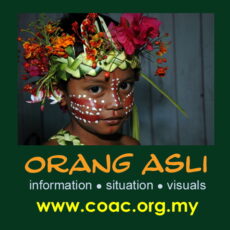SIMILARITIES WE OFTEN OVERLOOK
Christianity and Indigenous Religion Compared
Colin Nicholas
Published in SCR Reflections
No. 4. August 1989, Society for Christian Reflection.
I once witnessed a Christian missionary ‘praying over’ an Orang Asli man, who was not yet a convert. Nevertheless, he was obviously receptive of the idea of having someone place his hands on his head and invoke the help of some supernatural being. Then it struck me: this is no unusual scene. The Semai man had probably gone through this rite many times before – not with an outsider, but with his own shaman during the traditional healing ceremonies that they have.
Since then, each time I come across someone who regards his religion as being the “true religion”, and who treats indigenous religions as being “non-religions” at worst, or “animistic” at best, I am reminded of this scene, and of numerous other instances when it was difficult to tell the difference between the two religions – or at least their practices.
To name some: the sprinkling of holy water, the casting out of demons, the burning of incense, and the singing sessions where people go into a trance and speak in strange languages. No, I am not referring to any particular indigenous religion, though I could very well be. These are, mind you, forms of the practice of the Christian religion. The ancient Aztec civilization in Central Mexico, in fact, had a rite in which consecrated water was used to remove impurity from a newborn baby’s heart. Just how different is this from Catholic baptism?
Much of one’s existence, as the traditional cultures believe, is dependent on one’s relationship with the spirit world. A good harvest is attributed to the work of benevolent spirits. So too is a safe journey or a successful hunt. Everything is in the hands of the Spirit Being ‑ much like how Christians are wont to attribute all to the “power of the Holy Spirit.”
Like the latter which has been symbolically identified in the bible variously as a burning bush, a white dove and as tongues of fire, the indigenous cultures also believe that the Spirit Being manifests itself in certain living creatures and inanimate objects. On the surface, therefore, there seems to be no difference between the two views of the “Spirit”, yet, it is the indigenous religion which is regarded as “animistic.”
Space does not permit a discussion on indigenous religion ‑ which incidentally is more complex and theologically-sound than we are inclined to assume. (See Endicott’s Batek Negrito Religion (1979) and Signe Howell’s Society and Cosmos on the Chewong (1984) for an idea of two Orang Asli religions. Both are published by Oxford University Press.)
Nevertheless, while religion is generally accepted as a matter of belief, it also involves institutionalized patterns of behaviour – rituals, ceremonies, and the like – that express and reinforce religious beliefs. It is through ritual and ceremony that members of a society are brought into the realm of the sacred, where they are made to feel as if they are part of the supernatural.
Unfortunately, many of us tend to evaluate indigenous religions solely in terms of the rituals and rites which are often projected as primitive and ‘unscientific’. Since such judgments can only be made in relation to our own religions, it reveals an element of self-centredness in our perception of the religions of others.
The average Christian, it can be safely claimed, knows very little about indigenous religions. Often, only the visible rites and rituals are noted, and evaluations made based on these. Even so, in assessing rituals, the follower of the Great Religion would tend to apply a different standard of ‘scientific-ness’ to his own religion.
If we consider the meaning and purpose of rituals – acts which are repeatedly carried out routinely to achieve a state of consciousness where the presence of the supernatural is felt – we will see that there is very little difference in the use of rituals between various religions. There may be variations in a church service or a traditional healing ceremony, for example, but the basic format remains the same from one ‘service’ to the next. In all religious traditions, also, there have been various means of achieving the desired states of consciousness: fasting, flaggelation, self-torture, sensory deprivation, and ritual dancing and singing.
Rituals being considered as such, it should be now clear that indigenous peoples do not worship inanimate objects. They may accept that the wrath or blessing of the supernatural may be manifested in a flood or a good harvest respectively – as is also the case in the bible stories – but they do not pray to trees or stones or such objects.
The presence of the supernatural, in fact, is very much acknowledged in their daily living. Rules for individual and community behaviour – the basis of the indigenous social order ‑ place much emphasis on realizing the command of the supernatural: maintaining harmony. Harmony between the individual and nature, and harmony between individuals, therefore, is the core value that indigenous peoples subcribe to – and practice. Theologically, this is much like “building the kingdom of god on earth.”
Let us not pass hasty judgments, directly or indirectly, on indigenous religions for, after all, it has been said that the existence of gods or the truth of myths cannot be proven or disproven; we can only believe or disbelieve.

